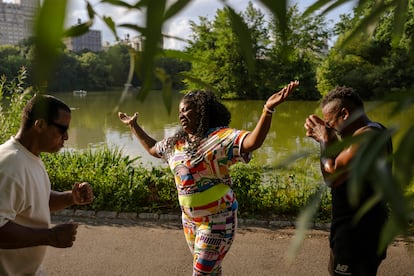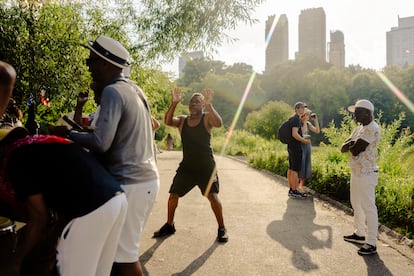It’s Sunday in New York and Willian Hart is particularly upset. He arrived at Central Park, crossed Strawberry Fields and did not stop until he sat down on a bench in front of the lake, very close to the Bow Bridge. He took out his basket with rums and beers and prepared to sell. “She, the one you see there, is playing with my money, she is taking what belongs to me,” he says, while pointing at a woman selling tamales, congrí rice, tomato salad, ropa vieja and beers.
That’s where his annoyance comes from. The beers. On Sundays there are certain unwritten rules, rules that neither the passing photographers nor the enthusiasts nor the dancers know, but that the Cubans, Puerto Ricans and Dominicans who have been making the profane drums of the Sunday rumba in Central Park sound for years do. If Willian Hart sells beers, no one else can do so around him.
Hart arrived in 1980 from Cuba to the United States, from Havana to New York, from Jesus Maria to the Bronx, aboard the ship Virginia. From the port of Mariel, 40 kilometers from the capital, Fidel Castro, in an act of political arrogance, allowed 125,000 Cubans, whom he later called “scum,” to leave the country and arrive in Key West. Hart is a “marielito,” like many of the party-goers in Central Park, or like Martha Castro, the 65-year-old woman who vigorously waves her fan, as well as her waist, and who furiously awaits the New York summer to attend the party.
The Central Park party, which has been going on for more than sixty years, according to some estimates, has no exact date for when it starts, nor one for when it ends. Its beginning is marked by the heat of the summer months, and its end by the cold temperatures of winter. This Sunday in July, the party, which begins around four in the afternoon, does not start on time. The musicians do not show up.
The park, however, begins to fill with people. Hart offers them beer, while Wanda Santos, the Puerto Rican he met five years ago in that same place, collects the money that she then puts in a small bag. They only accept cashif you ask about the possibility of a transfer, the answer will be that “only cashjust money.” Hart and Santos have been a couple since he arrived sadly at the party one day and she grabbed him by the arm and asked to walk for a while. Hart grew up surrounded by parties, in the patio of the house in the Jesús María neighborhood, where he will probably never be able to return.
-Never more?
—Esacly. I made many mistakes with the law. When you come from a country where you are not given access to anything, and you arrive in another where you see the doors open, you go crazy, you get lost, and when you react it is too late.
It is just after five in the afternoon and Bonifacio Pascual, or Boni, is ready to talk. To talk is to sing in the language of rumba. Rumba is a permanent dialogue between the drum and the clave, between the clave and the three two, between the three two and the guagua, between the guagua and the singer, between the singer and the chorus, and so on in all possible combinations. It is the rhythm and dance inherited from African ancestors, which took shape in the 19th century in Cuba and has since been the blackest expression of the Cuban neighborhood, and outside the island, a meeting place for exiles. In 2016, UNESCO declared Cuban rumba Intangible Cultural Heritage of Humanity.

Rumba has changed, as has New York City, as have its immigrants. Today it is different from the 1960s, when it was mostly played by Puerto Rican musicians at the Bethesda Fountain. The “marielitos” and later the so-called “balseros,” Cuban immigrants who crossed the Straits of Florida in 1994, brought with them the most up-to-date versions of guaguancó, columbia, or yambú from the neighborhoods of Havana or Matanzas, and the rumberos of New York joined in playing the newest rhythms from the island. But as much as it has changed, the essence of rumba is the same.
“Rumba is what we live. It is the ultimate expression of humanity, and one day it will be demonstrated,” says Boni, who has arrived at the park dressed entirely in white. When he was 20, Boni left the port of Mariel on the ship Rosemary. He remembers the day he arrived in the United States, and how magnificent, extraordinary, and amazing a supermarket seemed to him. “I saw how people bought things and my mind blew,” he says. “I said, but in Cuba you have to wait in line to eat a loaf of bread, and look at these people here, how they fill those carts. It couldn’t be possible.”
In a town in Pinar del Río, in the west of the island, he saw his father making drums and then extracting the rhythm from them. He has never returned to Cuba, but he always returns to Central Park. “It’s like returning to my country, this is like a nice rumba in a vacant lot,” he says. When the other musicians are ready, Boni gives the order in his hoarse voice: “But where was Hilda, tell me about your life,” he sings. The drums follow, then the claves. The rumba breaks out.
Today, El Chino, a 72-year-old Venezuelan babalawo, is also singing, singing as if it were always the last rumba. There is Lisa Maya Knauer, a 67-year-old professor at the University of Massachusetts, who twists and turns. She lifts her dress, shows her legs, does a twirl. This month, she has been attending the Cuban rumba for 30 years. “One day I was alone in the city, a friend had died, I was sad, and I said: where can I go now to find a little sense of community?” Lisa has been coming ever since, and dances without stopping.
There is also Alfredito, “Pescao,” who had not come to the meeting for several Sundays, but who does not stop singing today. There is “Matanzas,” a rumbero who plays the fifth box hard. There is Leonardo Whitman, who arrived in the eighties on the ship Maria Victoria, and who has no doubts that “to be a rumbero, you have to have the African heart inside.” He wears his white guayabera, linen pants and two-tone shoes. He is completely convinced, with that patriotic and musical impulse, that the rhythms do not sound the same if they are played by Dominicans or Puerto Ricans, as when they are played by Cubans. There are several young women who move their shoulders without moving their feet, and move their feet when they slide their hips. There are several families having a picnic, some boats and lovers cross the Bow Bridge, and in the background, the painting where the two baroque towers of the San Remo building rise, like a sacred image of the city.
There is also Rafael Corn, a French Broadway musician who once thought he was a rumbero, but in reality he was not. “I saw this and thought, well, conga, I studied conga, I have taken classes, I can play,” he says. Corn had studied percussion outside Paris. Many years ago, while living in New York, he heard the rumba in Central Park and wanted to play. He brought his drums, he was ready, but he was not allowed to join the sacred group of rumberos in the park. “I thought that if they were my drums, they had to let me play, but they didn’t let me either.”

Corn left almost crying. He was 18 years old. Then he went to Cuba, and he learned that rumba was something else. “It’s a whole atmosphere,” he says. Whenever he can, Corn goes to Central Park on Sundays. He is one of them and he knows, he is convinced, that you don’t have to be Cuban to give your soul to a drum beat. “There are Cubans who are terrible at playing,” he says.
Evening is falling in Central Park. The heat is relentless, sweat is smearing several faces. The lady selling tamales shouts that she has two left. A girl asks for a cigarette, please. The avalanche of people swirling around the drums says goodbye, disperses, disappears into the night. Someone begins to sing “Rosa, que linda eres” (Rosa, how pretty you are), and a diminished chorus repeats: “Rosa, que linda eres tú” (Rosa, how pretty you are).



